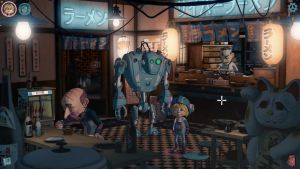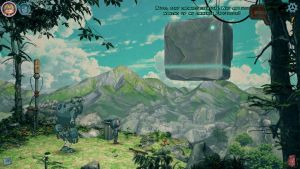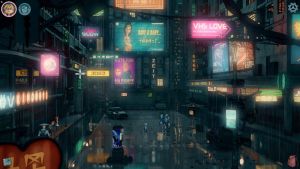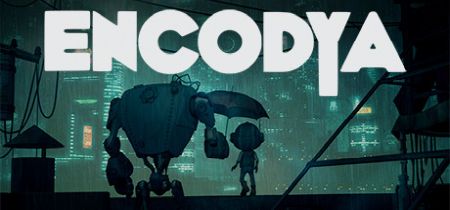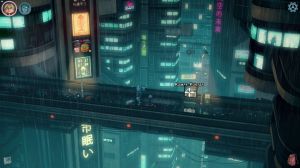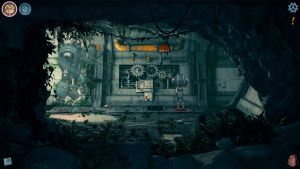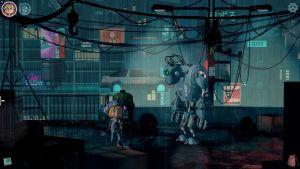|
By flotsam
Encodya
Chaosmonger Studio / Assemble
Entertainment
Well it took me a while, real
life and other things being what they are, but I was able to finish the
other day.
Encodya tips you into the
cyber-punk world of Neo-Berlin, accompanying 9-year-old Tina and her
guardian robot SAM-53 as they traverse the streets, alleys and rooftops
of the city. Played in the third person, the 3D character models
presented on pre-rendered backgrounds create streetscapes immediately
reminiscent of things like Blade Runner. Flashy, grungy, grimy; all feed
that impression. The VR addiction of the city’s residents adds a
Matrix-style control mechanism, which is the germ of the underlying
narrative.
What really gets things going is
Tina’s discovery of a message locked inside SAM from her father, which
she can’t unlock until her 10th birthday, but which the
powers at be now appear to want. Tina and SAM set off to unravel the
mystery/s.
There is a lot to like in
Encodya, the look and feel of the world being first among them. There is
so much in almost every screen that you forgive the short loads that
accompany each scene change. The level of detail is obvious, from big
things to little almost afterthoughts, and references to other things
abound, creating a rich and immersive world in which to play.
(And that one of the NPCs told
me about the futility of being a Fiorentina supporter blew me away!)
Tina and SAM are at the centre
of things, and their relationship works. It could have been so many
things, but I was convinced. The actors playing the parts have a fair
bit to do with that, as does the animation of SAM in particular. Indeed,
SAM does more than just hold up his end of things, and was pivotal I
thought in cementing the realism of the bond between him and Tina. So
much so that I switched to playing SAM a lot of the time. Which is not
to say that Tina doesn’t do an excellent job of being an orphan child
scavenging to survive in a bleak world, just that I really liked SAM.
As indicated, you can switch
between Tina and SAM at will, each of them following the other around.
Some tasks or conversations can only be carried out by one or the other
of them, which might result in eg. Tina saying something like “I think
SAM needs to talk to him,” but much of the time they are interchangeable
in terms of who you play, although their comments or observations may
well be different which is a reason to switch back and forth. They share
an inventory, so it doesn’t matter who gathers the item, although again
some items might only be able to be picked up and used by one of them
(heavy things for instance, way too big for a little girl to manage).
The score works better at times
than at others but I turn it down a lot anyway so it tends not to make
the same impression as it might otherwise. It did though heighten the
mood in places, and help sooth the beast in others. NPCs aren’t as well
voiced as the main characters but it’s a comparative thing; I don’t
recall thinking any of them were ordinary, let alone poor.
The completely point and click
nature of things will appeal to many, as will the ability to save at
will. Play in easy mode and you can ask SAM for hints, and the spacebar
will show collectable items (but not all hotspots). Or play hard and be
on your own.
The game explores some
contemporary ideas, and you can discover those for yourself. So too you
can form your own views about the despotic Mayor Rumpf.
There are some conversation
puzzles requiring you to choose the right responses in a sequence in
order to move on, but by and large the puzzling is inventory based,
involving finding and using the right items in the correct way. You can
combine items in your inventory, which sits in a ribbon across the
bottom of the screen and scrolls left and right. It is accessed via the
rucksack icon lower right, or by the mouse wheel, and can be hidden
until you want to look for something. Which is a good idea, because it
can occasionally get in the way of things you need to find if left
“open.”
As can SAM, and while he easy to
move, if you don’t know he is in the way it can be an issue,
particularly if you are playing on the Hard setting.
There are oh so many different
screens (one article I read said over 100), which is both a plus and
part of what I felt was the main minus of Encodya.
It is such a big place, with so
much going on and so many things to find, and it is very easy to miss
things. This is part and parcel of these sorts of games, but there is so
much to go back over if you don’t have the things you need. The design
of certain locations doesn’t help; four floors of an apartment building
for instance, or the various decks of a ship, just felt like unnecessary
back and forth. Moreover, “what to do next” can be directionless,
leading to more backtracking and wandering to try and move on. And there
are certainly times when I thought “why on earth would I think to do
that,” which I accept might be more about me than the game, but taken
together meant the game tended to overwhelm itself.
I did use the hints, and they
can help, but they can also be unhelpfully bland. I ended up having a
walkthrough close by for about the last third, which I should have done
earlier on, but which the strengths of the game made me want to avoid.
But I gave in, and enjoyed myself more as a result.
The interface is
straightforward. Hotspots will react to your curser, generating two or
three action icons, things like look, talk, or take. Hover your curser
over an item and your chosen character will likely look in its
direction, another nice immersive touch. Do the same on an inventory
item and a description will pop up telling you what it is. Click and you
will get icons to use or look, the former enabling it to then be used in
the gameworld. If it can’t be used in the way you tried, you will need
to select it again to try it somewhere else.
Arrows will pop-up in response
to your curser to indicate you can eg. enter a building, or access an
alleyway. This is where a short load will occur. Double-click the arrow
to “jump” there, or click to walk sedately. Point and click to move
around in the scene, or double-click to run. A map bottom left of screen
will also allow you to quickly access accessible locations.
Two icons sit top right, a cog
which accesses the menu and an exclamation point which contains your
objectives. Top left are images of Tina and Sam, and clicking one is how
you quickly and efficiently change your playable character. It clocked
in at about 12 hours of playtime.
Despite my misgivings, Encodya
provided a whole heap of entertaining upsides. A tighter more focused
game may well have produced something special.
I played on:
OS: Windows 10, 64 Bit
Processor: Intel i7-9700K 3.7GHz
RAM: Corsair Dominator Platinum RGB DDR4 32GB
Video card: AMD Radeon RX 580 8192MB
GameBoomers Review Guidelines
December 2021
design copyright© 2021
GameBoomers
Group
 GB
Reviews Index GB
Reviews Index |
